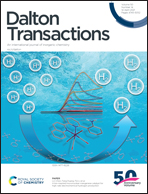Four 3D Co(ii) MOFs based on 2,4,6-tris(4-pyridyl)-1,3,5-triazine and polycarboxylic acid ligands and their derivatives as efficient electrocatalysts for oxygen reduction reaction†
Abstract
Different aromatic polycarboxylic acids are employed as auxiliary ligands to give rise to structural diversities in Co(II)-tpt (tpt = 2,4,6-tris(4-pyridyl)-1,3,5-triazine) frameworks. By introducing various secondary aromatic polycarboxylate anions, namely, biphenyl-3,4′,5-tricarboxylic acid (H3bpt), 1,3,5-benzenetricarboxylic acid (H3btc) and 2,6-dimethyl pyridine-3,5-dicarboxylic acid (H2dmdcpy) into the Co(II)-tpt system (tpt = 2,4,6-tris(4-pyridyl)-1,3,5-triazine), four new complexes [Co3(tpt)2(Hbpt)3]·0.5DMDP (1) (DMDP = N,N′ = dimethylpropyleneurea), [Co3(btc)2(tpt)(H2O)3]·3H2O (2), [Co2(btc)(tpt)2Cl]·DMDP·1.5H2O (3) and [Co(tpt)(dmdcpy)]·H2O (4) were obtained. Complexes 1 and 2 reveal amazing 3D networks in which the polycarboxylate ligands and Co(II) ions connect with each other to form regular 3D porous frameworks with 1D cylindrical channels partitioned by virtue of the tpt ligands. Complexes 3 and 4 exhibit unusual 3D frameworks constructed from the Co–polycarboxylate layers pillared by tpt ligands. In addition, compound 1 was chosen as a precursor to prepare Co, N-codoped porous carbon materials (denoted as CoNC) as an eletrocatalyst for oxygen reduction reactions. In particular, the effect of different nitrogen sources on the electrocatalytic performance of MOF derived carbon materials was investigated. We found that although different nitrogen-containing ligands have a certain effect on the electrocatalytic performance of the synthesized CoMOF derived carbon materials, the additional nitrogen source has a significant effect on it. CoNC-A derived from compound 1 exhibits greater limiting current density than that of a Pt/C catalyst, while CoNC-B derived from a mixture of compound 1 and dicyandiamide shows almost identical onset potential but remarkably more positive half-wave potential as well as higher limiting current density as compared to commercial Pt/C catalysts.



 Please wait while we load your content...
Please wait while we load your content...